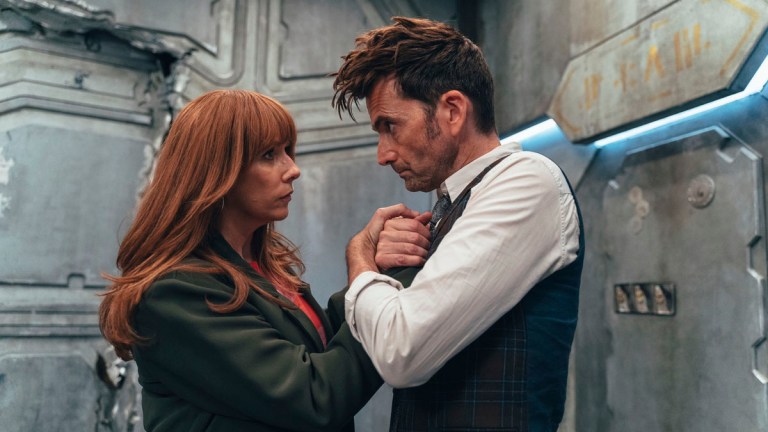Doctor Who: Wild Blue Yonder Review
Outside of everything, who can you really trust? Spoilers read your thoughts in this Doctor Who review…

Warning: contains spoilers for Doctor Who “Wild Blue Yonder”
The second of Doctor Who’s 60th anniversary specials has arrived, delivered in almost total secrecy that did a lot to stoke fan speculation and theories. Not only were shots from this episode conspicuously few and far-between in the promotional material, no advance copies were made available to the press, which is why you might be reading this slightly later than normal.
Honestly, I’m still not sure what all the fuss was about. The need for secrecy, I mean. The fandom was absolutely stoked, of course, theorising and piecing together the words-not-spoken to create the expectation of a multi-Doctor, madcap romp befitting a 60th Anniversary Special. Get out of here, “The Day of the Doctor!” Fie on your lack of CGI Eccleston! This is clearly set aboard the Memory-TARDIS!
That… was not a thing that happened tonight. But before we get to that, it’s only right and proper to talk about the things this episode actually did accomplish, and there are quite a few of them.
Far from being a romp of multiple Doctors, companions, villains or anything else, this story was as close to a two-hander as we’ve had in a good long while. Perhaps Scott Handcock (welcome!) is already showing his Big Finish pedigree, since he served as script editor there for many years, but despite the truly lavish sets (and… well we’ll get to the VFX) this is very much a tale exploring how the Doctor and Donna relate to one another, in isolation, during their post ‘Doctor-Donna’ entanglement.
Let’s rewind a bit. The Isaac Newton pre-title sequence is cute, lifted slightly by the fact they change history and then keep saying “mavity” for the rest of the episode. (It’ll throw off every “Where to start with Doctor Who” video if that quirk sticks for the next 60 years.) Next, the Doctor and Donna arrive – well, smash themselves into – something that’s probably a spaceship, and an entity is clearly watching them while an emotionless, computerised voice says… “Fenslaw.” Fenslore? Trenzalore? Coleslaw? I dunno.
The TARDIS is gone, perhaps removed by the reactivation of its Hostile Activation Displacement System. (I could rant at length about the wisdom of this ‘feature’ even existing, but we’re on a ticking clock here. What is Den of Geek without its Doctor Who review?)
Whenever the voice speaks, the physical layout of the ship shifts. Panels turn, lights flicker, and it’s all a bit Event Horizon. This isn’t stopping the Doctor and Donna from summoning a tuk-tuk and heading down the Very Long Corridor, though, passing a Very Old Robot as they do until they get to the control room (for a life-form with a bum) and confirming that they are indeed on a spaceship. Not a starship, though, for there’s an astonishing lack of stars…
So. The tone of this episode, if we’re replaying the Tennant/Tate hits, is “Midnight”. It’s the unknowable, inscrutable aliens who function on blue-and-orange morality, and just like “Midnight”, they’re copycats. Unlike that episode, the fact that they can and will communicate, if only to predate and hasten their own agenda, somewhat robs them of their scary-factor.
This isn’t to suggest that there aren’t genuine chills to be had when we, gentle viewers, first realise that the Doctor and Donna aren’t really talking to one another as they start to fix the ship. But by the third-such encounter the conceit is starting to wear thin. You can only riff on “But only I would know, except then only YOU would know…” for so long.
The lengthy middle act is made up of a lot of this banter, and it’s a little too often that the imposters are revealed by weird, uncanny CGI arms or other distorted body parts, gangling, dangling and twisting in unnatural ways, rather than being found out through intellect. Sometimes the resultant transmogrification works, and sometimes (like when the fake-Doctor twists under his own torso and starts scuttling along like Zoidberg) there are chase scenes that harken back to “The Lazarus Experiment”, which was even in its time derided for being a bit visually crap. Giant tangled messes of Doctor/Donna parts with inflated features and Brobdingnagian grasping hands don’t help.
“Midnight” might have been right never to show us the monsters.
Lore-hounds will likely have sat bolt-upright and then been a bit saddened when Tennant’s usage of salt suggests that maybe, maybe this pair of nameless aliens are Vampires, the long-past enemy of the Time Lords, but this is not to be. And having discovered that the ship’s captain activated a very slow self-destruct (at the hands of the Very Old Robot) and with the nameless aliens inexorably as clued-in as our actual heroes, the race is on as to whether the teams will commandeer the ship, or destroy it and prevent the copycats’ threat from ever reaching our universe.
What really works in these final moments is the terror that the Doctor really did take the wrong Donna into the TARDIS before the ship exploded. Just for a moment, that feels like a sickening possibility. It’s also really undercut when we learn that he noticed a tiny, Sherlockian detail about Donna’s wrists that viewers would have been oblivious to, but then, that’s the Doctor for you. At least he didn’t lick her.
The TARDIS makes it back to Earth where – surprise AND delight! – we’re greeted by Bernard Cribbins, reprising his performance as Wilfred Mott in the one episode of this trilogy nobody predicted he’d show up in. It’s lovely to see him again, even if his role is a little expositional, and that’s us for this week.
I think the perception of this episode will change over time, once it’s divorced from hype and marketing and nestled in a long iPlayer/Disney+ list to be enjoyed in its turn. It is absolutely fine. There are some janky VFX (still Doctor Who, then) contrasting some glorious set design. Murray Gold’s score is stellar as always.
That said, I suspect the aggressive secrecy and resulting hype, which never quite got paid off, might salt the discourse – for this weekend, at least. But it’s understandable in hindsight! How can you show footage from a story that’s pretty much just two Doctors and two Donnas without spoiling the entire premise?
Even so, perhaps this particular outing might have been better served parked for Ncuti Gatwa and Millie Gibson, who could still have had genuine reason to distrust each other, trying to take the measure of their new travelling companion, rather than 15-years-long friends trying to catch one another out via trivia.
Viewed through the lens of a 60th Anniversary Special treated with over-the-top secrecy, this doesn’t quite work. It’s also too disconnected to form the middle act as a trilogy of ‘movies’, which is how Disney+ seems to be classifying them, if this is how we’re meant to be thinking of the Fourteenth Doctor’s arc. As a standalone story, I enjoyed it more, though it’s not likely to catapult itself into my top 10 thanks to a few too many variants on the central copycat dilemma.
Next week: Neil Patrick Harris plays The Master of the Land of Fiction. (Look, I’ve not heard “Toymaker” spoken on screen yet. A man can dream…)
Doctor Who continues with “The Giggle” on Saturday December 9 on BBC One and iPlayer in the UK, and on Disney+ around the world.
